6 Types of Lawn Diseases (With Pictures)
-

- Last updated:

We all strive to make our outside spaces neat and clean, and that includes having the perfect green lawn. Still, like other plants, grass is prone to diseases and if we don’t treat our lawns properly, we could be dealing with many potential issues.
Today, we will discuss six types of lawn diseases, mentioning their favorable conditions, host species, and how to control them if they occur.

The 6 Main Types of Lawn Diseases
1. Dollar Spot Lawn Disease
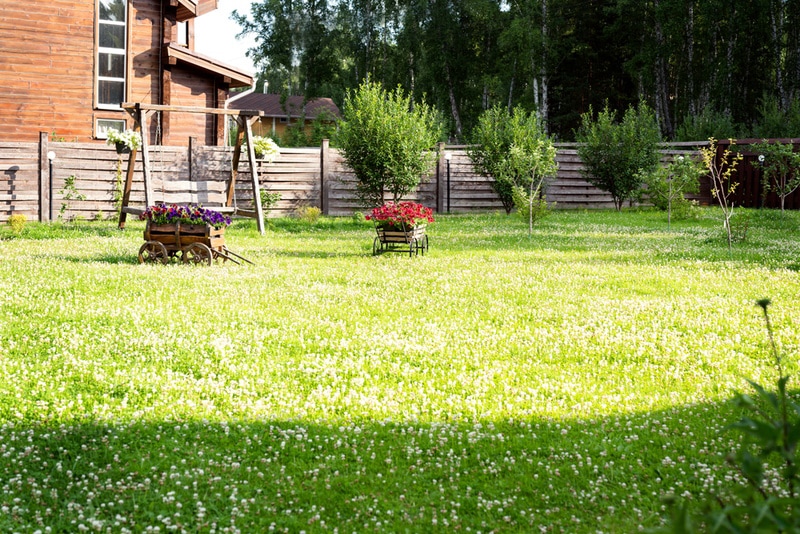
| Favorable conditions | Temperatures between 59°F and 86°F, excessive moisture, low nitrogen |
| Host species | Most turf species |
| Control | Remove morning dew, apply nitrogen |
Dollar spot lawn disease shows up as small, pale turf patches that can become up to 6 inches wide. This disease is typical of turf species such as bentgrass, fine fescue, Kentucky bluegrass, and perennial ryegrass. Warmer temperatures and humidity promote this disease, so it’s more common from spring to fall. Dollar spot lawn disease can kill your turf and cause a lot of damage, so you should act quickly once you notice it.
How to control it?
The best way to reduce the chances of dollar spot lawn disease is to provide your lawn with regular maintenance. You should mow the lawn regularly, add nitrogen when needed, and avoid overwatering.
2. Red Thread Lawn Disease
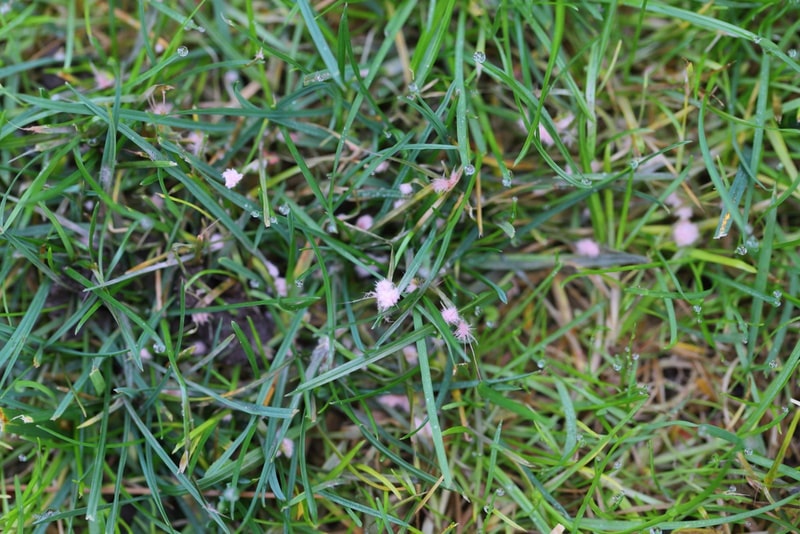
| Favorable conditions | Any area with a temperature between 59°F and 77°F, humid conditions |
| Host species | Various turf species |
| Control | Provide adequate soil nutrition, apply nitrogen when needed |
Red thread lawn disease shows up as bleached or red patches on the grass. However, you can easily control it when you identify it, and you’ll easily notice reddish threads on your shoes and mower. It typically appears on turf species such as bentgrass, bluegrass, fine fescue, and perennial ryegrass. Mild temperatures, too much shade, and humid conditions favor the disease and make it spread rapidly. This fungus won’t kill your lawn, but it will make it look unappealing and may cause other lawn diseases too.
How to control it?
Providing adequate fertilization, regularly mowing, and not overwatering your lawn will help you control red thread lawn disease. You could also purchase a fungicide that will help control this disease, but it’s best to first try natural methods before switching to chemical solutions.
3. Brown Patch Lawn Disease
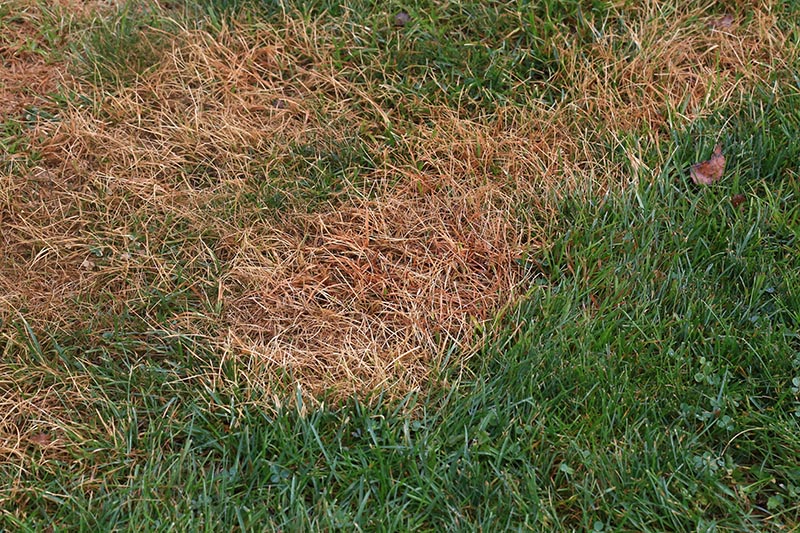
| Favorable conditions | Temperatures between 46°F and 104°F are favorable for this disease |
| Host species | Most turf species |
| Control | Avoid excessive thatch and applying too much nitrogen, try and reduce moisture |
Brown patch lawn disease is common from spring to fall when the temperatures are high and the outdoor conditions are humid. It’s very widespread and easy to identify. This fungus likes turf species, so it’s a typical disease that attacks grasses like tall fescue, Kentucky bluegrass, and perennial ryegrass. You will easily recognize brown patch lawn disease as it leaves circular brownish patches. The good thing is that this disease is not complicated to cure, so you should be able to cure your lawn of it quickly.
How to control it?
To prevent brown patch lawn disease, you should practice a regular maintenance routine for your lawn. That includes fertilizing, reducing thatch, mowing, and infrequent morning watering. If that doesn’t work, you can always try out fungicides that should stop the disease.
4. Anthracnose Lawn Disease
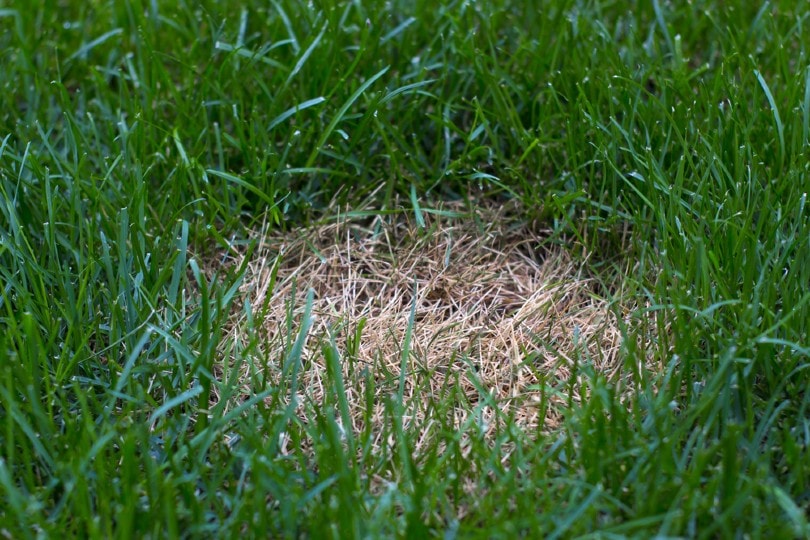
| Favorable conditions | Temperatures between 78°F and 95°F help this disease spread |
| Host species | Turf species but especially common in wintergrass |
| Control | Provide enough nutrients, reduce moisture and stress |
Anthracnose lawn disease typically attacks turf species, such as fine fescue, bentgrass, and Kentucky bluegrass. However, it’s most common for wintergrass. It appears as reddish-brown irregular patches that turn brown or yellow. This disease spreads at temperatures between 78°F and 95°F in humid conditions on lawns with low nitrogen and inadequate soil. Anthracnose is another disease that you can quickly fix with little time and effort, after which you should continue regular maintenance and upkeep.
How to control it?
Regular fertilizing, mowing, and preventing overwatering can help control this lawn disease. If that doesn’t help, you can turn to fungicide products that should resolve the issue for you.
5. Fairy Ring Lawn Disease

| Favorable conditions | Outdoor conditions from spring to autumn promote the spreading of this lawn disease |
| Host species | All turf species |
| Control | Applying fertilizer, removing mushrooms |
Fairy ring lawn disease is common for all turf species, and you’ll easily recognize it because of the mushrooms that will appear on your lawn. They love humid, shady, damp, and wet conditions, so the spreading of this disease will depend on how well you take care of your lawn. The mushrooms can be well hidden under the ground, breaking the organic material of your soil. Fairy ring lawn disease typically appears during the summer months, but it can also happen in fall/winter in areas with warmer climates.
How to control it?
To prevent fairy ring lawn disease, you should regularly fertilize your lawn and provide enough nutrients. However, you should avoid overwatering and adding too many soil amendments. Fairy ring is another disease you can cure with fungicides if other methods don’t work.
6. Rust Lawn Disease
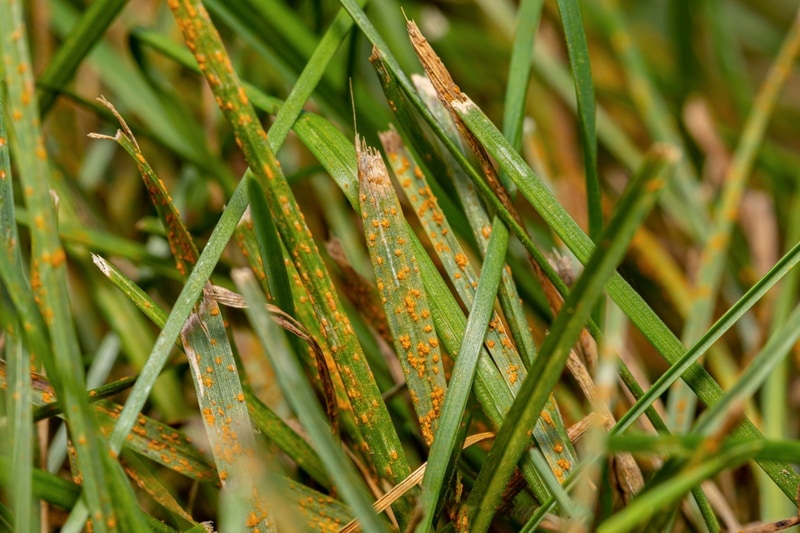
| Favorable conditions | Temperatures between 68°F and 86°F are favorable for this disease |
| Host species | All turf species |
| Control | Wash mowers after mowing an infected site |
Rust lawn disease is another disease that can appear on any turfgrass species, and it’s unique due to the rusty-yellow specks that appear on the leaves. The grass can become thin and prone to other lawn diseases when infected with this disease. It’s the most common in bentgrass, fine fescue, tall fescue, and Kentucky bluegrass. You can encounter rust lawn disease during the summer months since it thrives in temperatures between 68°F and 86°F, and too much shade and water help promote its spreading.
How to control it?
Rust is another lawn disease you can fix with regular maintenance and adequate care for your lawn.

Final Thoughts
Lawn diseases are quite common, so if your lawn gets one of the diseases we mentioned, there’s nothing you should worry about. With proper care and maintenance, you can heal your lawn in no time and make it beautiful again. Once the disease is cured, ensure you practice regular maintenance to keep your lawn healthy.
- See Also: 10 Reasons Plant Leaves Turn White
Featured Image Credit: SingjaiStocker, Shutterstock
Contents
